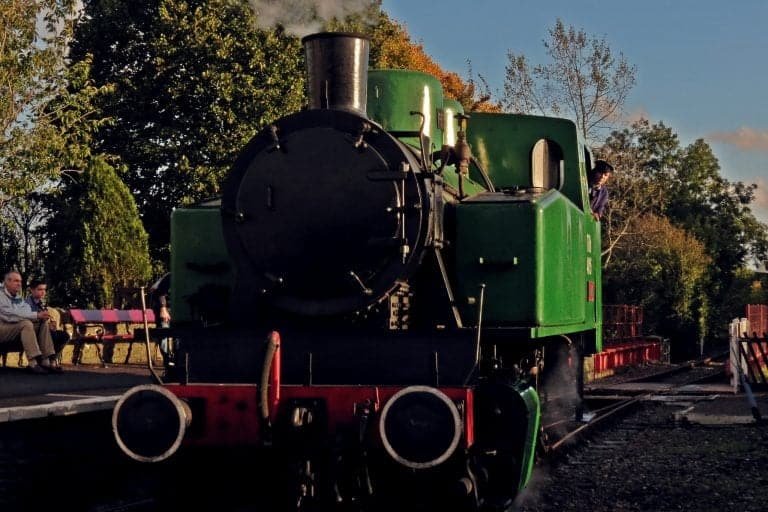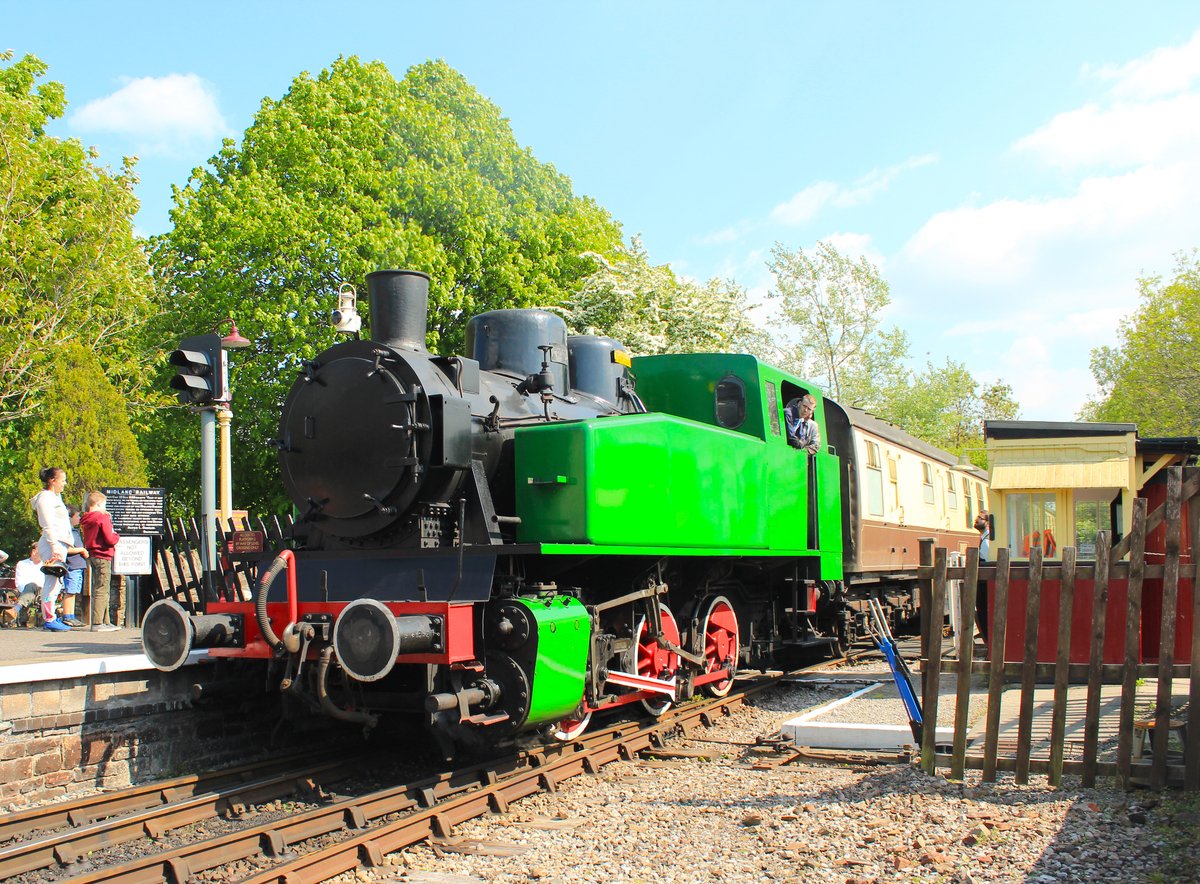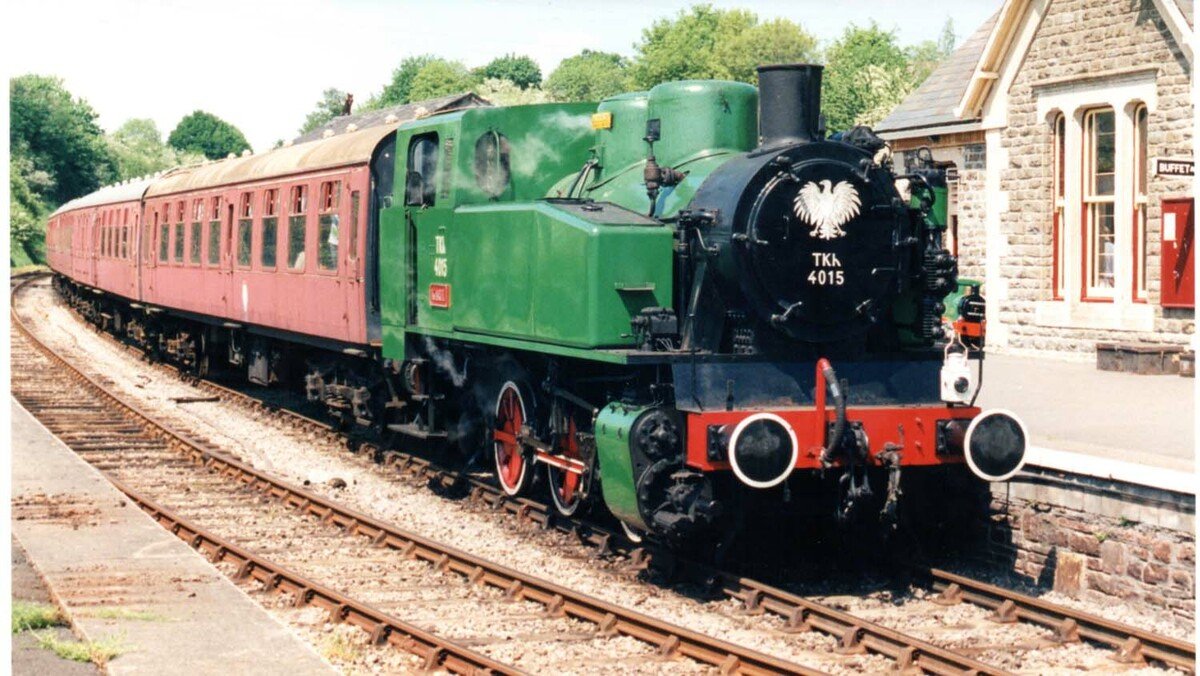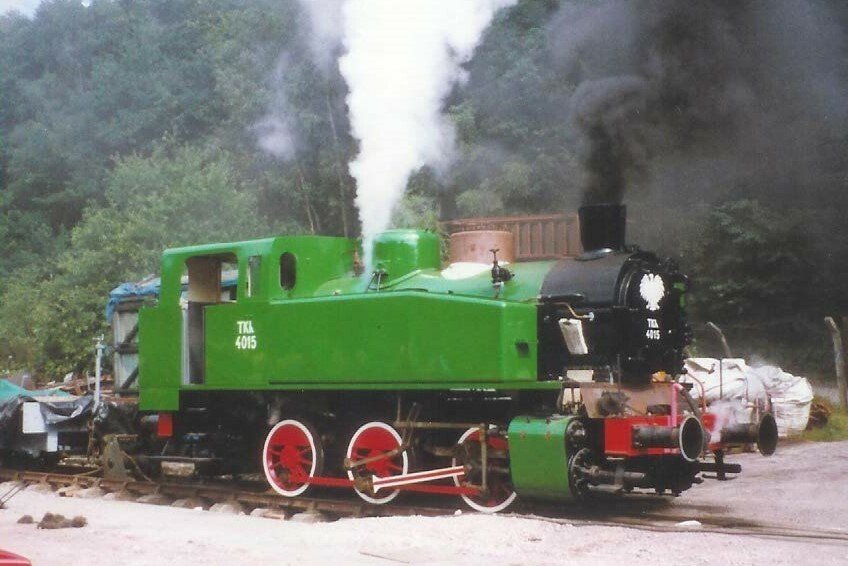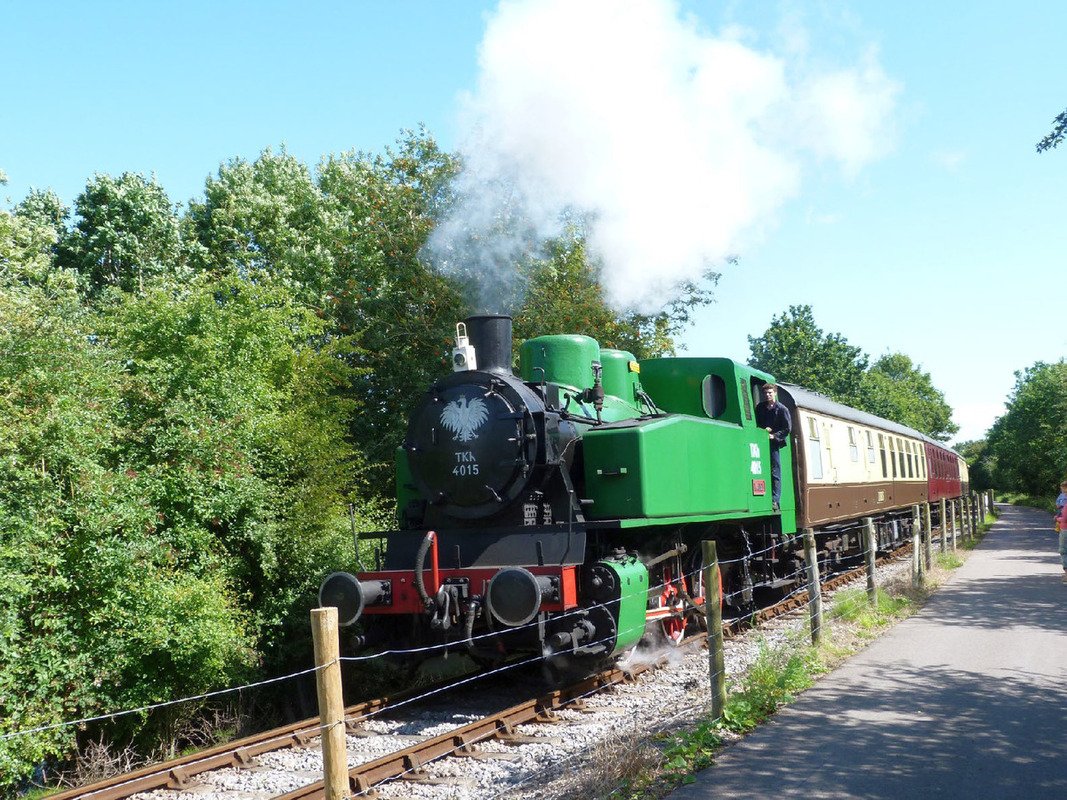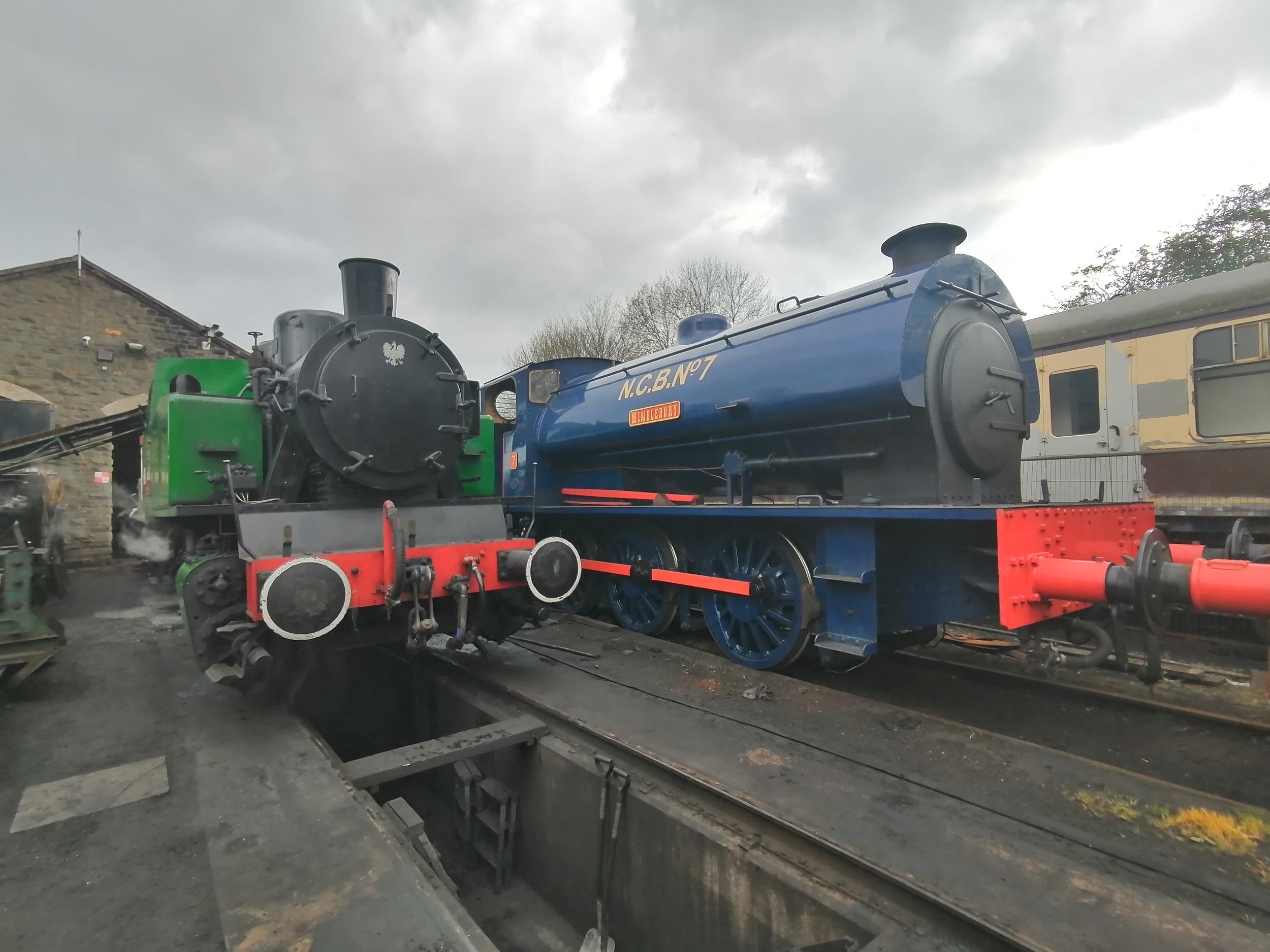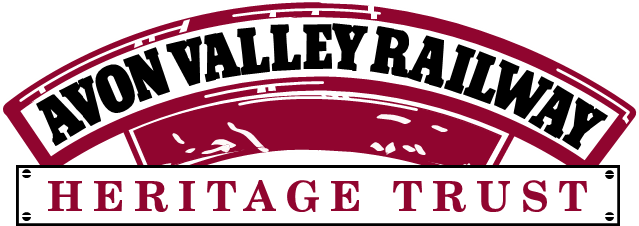Chrzanow Ferrum 0-6-0T No. 4015 Karel
Number(s): 4015
Construction year: 1954
Builder: Chrzanow
Owned by: Private owner Rob May
Status: In Service
During two decades at the Avon Valley Railway, loco No. 4015 Karel has become a familiar sight ticking all the right boxes for visitors who need simply the sounds and smells of steam to conjure up the romance of travel in times gone by. A steam engine with six driving wheels is just the right size for hauling up to seven carriages or a rake of goods wagons over a few miles of track and there are dozens of such engines up and down the country doing exactly that. But Karel is a little different from most. The engine's distinctive outline, the shade of green it sports, and its white-rimmed red wheels are authentic, but would not be familiar to old-time British steam enginemen, because, as the works-plates and eagle symbols show, this locomotive is from Poland. How did it come to end up on a Midland Railway branch line, hundreds of miles from its native land?
First Factory
Karel’s story begins in Chrzanów , in southern Poland, about 60 miles from the borders with Slovakia and the Czech Republic. In 1919, with the turmoil of the First World War behind it and part of a new Polish nation state, Chrzanów became home to the grandly-titled “First Factory of Locomotives in Poland”, always better known as Fablok, an abbreviation of Fabryka Lokomotyw, or locomotive factory.
Fablok went on to produce over 10,000 engines for use both in Poland and further afield. Notable achievements included the construction of Luxtorpeda (“luxury torpedo”) high speed diesel railcars, manufacture of electric locomotives under license from Metropolitan Vickers, and outshopping two experimental and prize-winning Pm36 express passenger locomotives. One of the less prestigious products was a class of 480 lightweight, robust, low-maintenance 0-6-0 tank locos for use in industrial settings with sharply curved tracks in Poland, Eastern Europe and China, called the T3A “Ferrum” (Iron) adapting, after the second world war, designs from Austrian-inspired T1A and T2A locomotives which had been constructed back in the 1920s. Karel may bear a passing resemblance to a wartime USA tank engine – a class which worked Southampton Docks until the 1960s – but this is an example of parallel evolution producing a practical design for a robust locomotive to do a simple job on both sides of the Atlantic.
In service the locos were often officially known by the abbreviation TKh (“T” meaning a freight loco, “K” a tank engine, and “h” an 0-6-0) and their works number so “Karel” carries the number TKh 4015.
Construction and service
Construction of the Avon Valley’s No. 4015 began in 1954, but Fablok’s boilers were made elsewhere, and records show that it sat without one for three years, before finally being completed and rolled out of the Chrzanów factory in 1957. It was sent 125 or so miles North-East to Ostrowiec (pronounced Ostrov-yets) steelworks in South East Poland. There it stayed, apart from two brief trips to Olesnica locomotive works for overhauls, until 1991.
New Beginnings
Steam power on Poland’s industrial railways continued for some decades after it had died out in the UK, but by the 1990s that era was coming to an end along with Communism. When Lech Walesa and General Jaruzelski formed their unlikely alliance to implement Perestroika in Poland between 1996 and 1990 the result was Poland ready-prepared for the fall of the Berlin Wall, the fall of Soviet Communism and a pathway to democracy. However, the transition was very painful. Along with most of Poland’s heavy industry, the Ostrowiec Steelworks was in deep trouble without orders coming from the central authorities. Their locomotive fleet was withdrawn from service in 1991 and put up for sale for US Dollars – because the artificial value of the Polish zloty had also been exposed (on a previous visit in 1986 Karel’s owner, Rob May, had changed Sterling to Zloty on the black market at over ten times the official rate).
As steam power waned in Eastern Europe however, in the West a new industry had found a use for it – heritage. In the UK, the public’s appetite for steam was accelerating as fast as the established lines could restore locos. The famous scrapyard at Barry was emptying of former mainline locos and those remaining were missing most of their working parts. The days of buying working engines direct from British industrial sites had long gone too.
Rob May had seen redundant, but complete, main line and industrial steam locos from the carriage windows of a Polish rail tour in 1986 and thought that he might be able to strike a “hard currency” deal for one of the smallest of the Polish loco types that could almost fit the UK loading gauge. The Ferrum type is about 4 inches over gauge across the cylinders but otherwise within gauge.
A few months and “a little networking” later, Rob and a translator found themselves in the boardroom of Ostrowiec steelwork, and he was able to complete the purchase of No. 4015. Although it had been in use relatively recently, standards which passed muster back at the steelworks would not have impressed UK inspectors, and so the loco was dismantled for overhaul to commence.
Most of that work was undertaken at Bill Parker’s Flour Mill works in the Forest of Dean, with the engine being ready in time to pull Cholsey and Wallingford Railway’s trains in the second half of 1998. One unusual finding by the Flour Mill team was that the regulator valve rings had been removed whilst the loco was in Poland. The effect of that would have been to greatly reduce the power output, so we wondered whether this loco had latterly only been used for driver training.
The name Karel
Rob named his loco Karel by mistake! The given Christian name of Pope John Paul II, a Pole who had made history in 1978 by becoming the first non-Italian head of the Catholic church in over 400 years, is Karol, with an O. Although not religious himself, Rob explains that the name is a nod to Polish history, and to the country’s people, whose hospitality he had greatly enjoyed, and whose struggles against many invaders and oppressions he admires. Rob’s brother had already made the pattern for the nameplates to be cast in aluminium before Rob realised he had given him the wrong spelling!
But there was also a more practical reason behind the choice of name, which is a play on that of his wife, Carole. “If you’re going to buy something that expensive,” Rob advises, “name it after your partner!”
Delightfully Different
Karel has now been in heritage service for most of the last 23 years. After the brief spell at the Cholsey and Wallingford, the loco spent two years at the Pontypool and Blaenavon, a year at the North Norfolk Railway and has made a short visit to the Nene Valley Railway.
Otherwise, it has found regular work and an appreciative home at Bitton and benefitted from a great deal of practical support from Bill Parker and his team at the Flour Mill Works at Bream. As a result, unlike its UK-based classmates, it has spent only short periods of time out of service apart from overhauls, in 2003, 2013 and 2019. The most recent costly overhaul replaced almost all of the boiler apart from the barrel, so Rob hopes its life will have been extended for at least another 20 year, but a combination of COVID and an unexpected major fault has meant Karel saw no use at all in 2020. Karel is now fit and ready for service in 2021 and, hopefully for the next five years.
What’s next?
By 2025 Rob will have owned Karel for 34 years which is just as long as its entire working life in Poland! Rob is committed to No. 4015 remaining permanently part of the fleet at Bitton but, if at some time the AVR finds itself with more steam power than it needs, Karel may go off on loan again to other UK heritage railways.
Written by:
Rob May, May 2021
TkH 4015 is pictured at the steelworks in Poland before purchase © Rob May
Karel undergoes a steam test at the Flour Mill in 1998 © Rob May
Karel drifts into Bitton Station in the year 2000, when facing south.
Karel is pictured here at Weybourne on the North Norfolk Railway © Rob May
Karel arrives at Bitton with a train from Avon Riverside. © A Ashford

